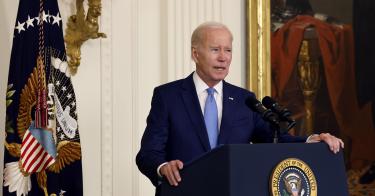Creeping executive overreach, not envisaged by Congress in the original missions or purposes of cabinet agencies, is driving up the price of energy and energy-related products. This is raising costs for all Americans, and poor and middle-class people are disproportionately paying the price.
The Biden administration is using the so-called existential threat of climate crisis as an excuse for overreach and has deployed the full brunt of the executive branch’s powers in his quest to reduce greenhouse-gas emissions. This runaway federal bureaucracy is now trying to control our lives for no apparent benefit while making us poorer and less secure—and trampling the separation of powers and federalism along the way. By creeping over the limits on its power, government is switching off the power for growth.
Led by the White House, mission creep can be found at the Environmental Protection Agency, the Council on Environmental Quality, the Office of Comptroller of the Currency, the Securities and Exchange Commission, and the Federal Energy Regulatory Commission.
The higher prices for electricity and transportation that are the result of such administrative overreach bring no climate benefits. Even completely eliminating all fossil fuels from the United States would result in less than 0.2 degrees Celsius in temperature mitigation by 2100, according to research using the EPA’s own climate models.
But Biden’s efforts aren’t only ineffective, they’re unconstitutional. The EPA’s attempt to regulate regional emissions through a novel interpretation of the Clean Air Act, known as the Clean Power Plan, was proposed in 2015 under President Barack Obama and deemed executive overreach by the Supreme Court in West Virginia v. Environmental Protection Agency on June 30, 2022. Under the Clean Power Plan, if emissions exceeded the EPA’s requirements, a state, or group of states, would be required to shut down power plants or to install renewable-energy sources.
>>> Energy Department’s Costly Bid to Regulate Gas Stoves Out of Existence Inflames Consumers
Ruling 6–3, the Supreme Court decided that the Clean Air Act does not allow the EPA to move from regulating individual power plants to regulating regional emissions. If the Court had found the other way, the EPA could have changed the entire vehicle fleet to electric vehicles (EVs) through a change in regulation.
Carbon emissions are declining as domestic supplies of natural gas replace coal. Emissions of energy-related carbon dioxide declined by 18 percent from 2007 to 2021, according to the Energy Information Administration. Between 2014 and 2021 these emissions fell by 9 percent.
Despite this natural decline, creeping executive-branch oversight of energy started early in the Biden White House. On his first day in office, President Biden revoked the permit for the Keystone XL pipeline, which would have brought 850,000 barrels of oil per day from Canada to be refined in U.S. refineries. He also reduced oil and gas production by expanding the boundaries of the Grand Staircase–Escalante, Bears Ears, Northeast Canyons, and Seamounts Marine National Monuments. Those areas are now off limits.
Higher gasoline prices and inflation followed, with Biden asking Saudi Arabia and Venezuela to produce more oil, rather than rolling back his regulations.
On August 5, 2021, President Biden issued an executive order setting a goal that by 2030 half of new vehicles sold in the United States would be electric, including different types such as fuel-cell electric, plug-in hybrids, and full battery electric. Congress would never pass a law mandating such a high share of EVs, so President Biden has to do it through regulations and executive orders, following the lead of California and other states seeking to reduce emissions.
The White House’s Council on Environmental Quality (CEQ) issued new guidance on January 9, 2023, requiring federal agencies to use the National Environmental Policy Act (NEPA) process to reduce emissions from greenhouse gases. Now, projects that result in higher greenhouse-gas emissions will find it harder to get NEPA approval. The guidance takes effect immediately, without waiting for CEQ to address comments from the public or the regulated industries. To make matters worse, some agencies are including factors that Congress did not originally intend in their NEPA compliance. This is an example of a harmful, arbitrary, and capricious policy.
The EPA followed that up with new, costly proposed regulations on automobile emissions that would require new car sales to be 60 percent battery-powered electric by 2030 and 67 percent by 2032. In 2022, fewer than 6 percent of new cars sold were battery-powered electric.
New EVs cost more than gasoline-powered vehicles. Used EVs have low resale value, because it is difficult to evaluate how long the battery will last, and replacing an EV battery can cost anywhere from $5,000 to $20,000. Recharging an electric vehicle from empty can take over an hour, and battery-powered vehicles lack sufficient range to satisfy most customers. Batteries lose up to 40 percent of their range in cold climates.
Although more EVs will create a need for additional electricity, the EPA is planning new expensive rules for power plants, driving up the costs of the electricity needed to charge these vehicles. The EPA will regulate carbon dioxide and other so-called greenhouse-gas emissions from both new and existing natural-gas and coal-fired power plants. These plants would be required to install carbon-capture systems or switch to hydrogen fuels, passing on costs in the form of higher electricity rates.
Meanwhile, the Office of the Comptroller of the Currency (OCC), which regulates banks, has appointed a chief climate risk officer, Yue Chen, to assess and to monitor climate-driven risks to banks. Chen, who does not have a background in risk assessment, has engineering degrees from Tsinghua University in China and from the Massachusetts Institute of Technology. Monitoring climate risks to bank lending and assets will have the effect of discouraging investments in fossil fuels and will allow the investigation of companies and banks that the OCC believes are making the “wrong” investments or loans.
The Defense Department, which has the mission (as its name would suggest) of securing the defense of the United States, wants to use biofuels to make its military vehicles and jets more climate-friendly. Such vehicles are less resilient and more costly, so the Pentagon would be able to afford fewer of them, with major effects on national security.
>>> White House’s Expensive and Unrealistic Push for Electric Vehicles
In finance, the Securities and Exchange Commission (SEC) is going beyond its statutory authority and wants to stick its fingers into energy production. SEC chairman Gary Gensler has proposed rules to require companies to disclose information about the following: governance and management of climate-related risks, how climate-related risks will affect companies’ strategy and outlook, and the effects of climate events such as hurricanes and wildfires on financial statements. This rule would further reduce America’s energy independence and make it more difficult to get capital for fossil-fuel investments.
Together, all these rules are reducing Americans’ job prospects in the oil and gas fields while Chinese corporations (sometimes utilizing forced labor) are prospering as they flood global markets with wind turbines and solar panels and pump batteries and electric-vehicle components made in factories that run on dirty coal power. China makes nearly 80 percent of the world’s electric batteries, over 80 percent of global solar panels, and almost 60 percent of the world’s wind turbines.
To produce these renewables, China is increasing its construction of coal-fired power plants. America has 225 coal-fired power plants. China has 1,118 (half of all the coal-fired plants in the world). That is one reason why China has increased carbon emissions by over 5,000 million metric tons over the past 16 years. America’s carbon emissions have declined by over 1,000 million metric tons over the same period owing to the use of clean natural gas.
China has not committed to reducing emissions until 2027. As mentioned above, even completely eliminating all fossil fuels from the United States would result in less than 0.2 degrees Celsius in temperature mitigation by 2100, according to research using EPA’s own climate models. Under the administration’s climate regime, Americans—especially the poor and middle class—would be bearing major costs in higher electricity prices, higher food prices, and a forced switch to costly EVs. All this without any material benefit for the environment.
Owing to hypocritical, bureaucratic, executive-branch mission creep, America will effectively depend on energy from China, rather than using its own oil and natural gas resources. To turn things around, Americans should aspire to remind the Biden administration that it is not above rule of law. The Supreme Court weighed in on that balance in 2022, and it could weigh in further in the years ahead.
This piece originally appeared in the National Review




